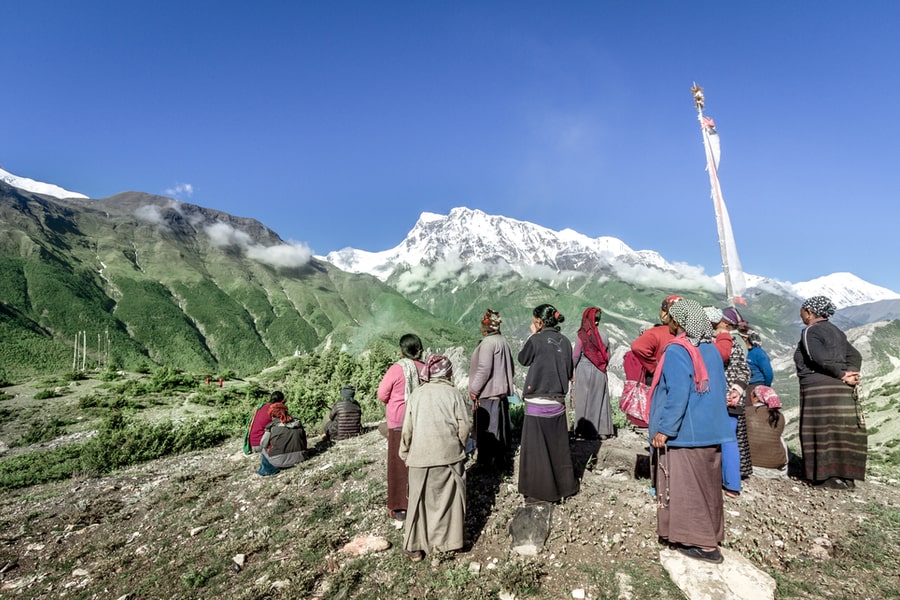
Everything You Need to Know About the Tibetan Sky Burial
While all of humanity is united in its desire to ritualize and memorialize their dead, there are huge swathes of differences in what cultures consider to be sacred or profane. Some of the differences are so great that what one culture might consider sacred, others might consider profane. Here in the west, the dead body is sacred, with heavy influences from Christianity saying that the earthly body will rise again. Westerners bury the body, or more often these days, cremate the body and either bury the remains in a burial urn or use a unique cremation urn to store or display the ashes in the home. Whether buried or cremated, the body is revered.
However, halfway around the world in Tibet, the way they approach death is very different. The approach is so different that Westerners might be shocked at their death rites. In this article, we’ll explore the Tibetan practice of Sky Burials.

What is a Sky Burial?
A sky burial is a common practice in Tibet and has been for thousands of years. Instead of burial or cremation, after a person dies, their body is taken to a special monastery. There a sky burial operator will dismember, or chop into pieces, the corpse. They will then lay out the remains at a special sky burial site to feed vultures. Vultures are considered sacred by the Tibetan people. Every night the lamas, or spiritual masters, at the monastery read sutras, or scriptures, for the dead. These recitations can go on all night.
One of the reasons that Tibetans have sky burials is because they practice Buddhism. Feeding the body to the vultures is considered to be a final act of charity, or kindness. In their minds, the spirit of the person moves on and the body is an empty vessel. This is called transmigration of the spirit. By exposing the body to the elements and animal scavengers, the body is returned to the earth as generously as possible. The choice to have a sky burial is called Jhator, an act of generosity. Buddhism teaches compassion for all beings and leaving your body as food for the earth and its creatures is considered to be a final act of compassion.
Sky Burials Instead of Urns
Tibet has 1,075 sky burial sites and 100 people to conduct the rituals. These rituals take place at monasteries, like Drigung Til Monastery, which is the largest. They process about 10 bodies a day at the 900-year-old monastery. The death rituals are considered auspicious or blessed with good luck. It takes a skilled sky burial operator about 2-3 hours to “dissect, smash and feed the bodies to the vultures”. These rituals are an important part of Tibetan life, and the sky operators feel valued as they carry out this sacred work.
The sky burial operators only rest one day a month, on the 19th. This is because, according to a Tibetan Buddhist sutra, the divine beings in Heaven congregate together on this day of the month, and they don’t want to see or smell blood.
While this may sound strange to the average Westerner, or at the least very different, the Tibetans have very specific reasons for this practice. One of the practical reasons for sky burials is that there is not a lot of wood to be found, because most of Tibet is above the tree line. This means that burning a body is reserved for people with a very high social standing. Another practical reason for sky burials is that the ground in Tibet is hard and rocky, which makes digging a grave quite challenging.
This practice is recognized by Tibet’s central and regional governments. And the practice is heavily protected. The government blocks outside visitors from observing or participating in the rituals and no one is allowed to take photographs. These practices show respect for the rituals and the dead themselves.
While there are two other ways that Tibetans can lay their dead to rest, cremation and water burial, the sky burial is incredibly popular and practiced by about 80 percent of the population. To give an example, the central Tibetan government built a crematorium that wasn’t used for several months. The crematorium was built in October of 2000, and the first body cremated there was not done until January 2001. Cremation isn’t popular among Tibetans because of thousands of years of traditions.
The Living Urn's Unique Options
If you’d like to borrow a page from the Tibetans and have a water burial, The Living Urn has two unique water urns to choose from. One of their water urns has a dissolvable bottom, which allows for the safe release of ashes into whatever sacred body of water you choose.
They also have the uniquely beautiful Flow ice urn, which slowly dissolves to release the ashes of your loved one. Whatever your urn needs are, whether it’s a burial urn, or a cremation urn, The Living Urn has a beautiful and sustainably made urn for you.




